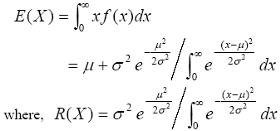A. Partial Distribution and related results
Definition 1 (The Partial Distribution). Let X be a non-negative stochastic variable, and it follows the distribution of density
 (1)
(1)
then X is said to have a Partial Distribution, and denotes XεP( µ, σ2). The partial distribution is a kind of truncated normal distribution.
Definition 2 (The Partial Process) If stochastic variable X is
related to time, i.e tε[0,∞), we have X(t)εP( µ(t), σ2(t)),
then the {X(t), tε[0,∞)} is called a partial process. If X is a non-negative stochastic variable, and XεP( µ, σ2), we have the following research results from [11], [12]:
tε[0,∞), we have X(t)εP( µ(t), σ2(t)),
then the {X(t), tε[0,∞)} is called a partial process. If X is a non-negative stochastic variable, and XεP( µ, σ2), we have the following research results from [11], [12]:
1) The expected value E(X) of X, is as follows
 (2)
(2)

is the margin of E(X) and µ.
2) The variance D(X), is as follows
 (3)
(3)
3)
 (4)
(4)

4)  (5)
(5)
B. The Method of Measuring RL
If we regard µ as APL, and σ as the fluctuation spread (standard variance) of APL, and assumption 1—assumption 3 are all tenable, the variable X of RL satisfies the partial distribution according to [11], [14], i.e. XεP( µ, σ2). So we have the following deductions:
1) The average of RL is

the average margin of RL and µ.
2) The variance of RL is

We could think D(X) as the actual risk of RL.
Prof. Feng Dai, Prof. Song-tao Wu, Prof. Ya-jun Zhuang
Next: The prospect utility function and analysis of risk preference
Summary: Index